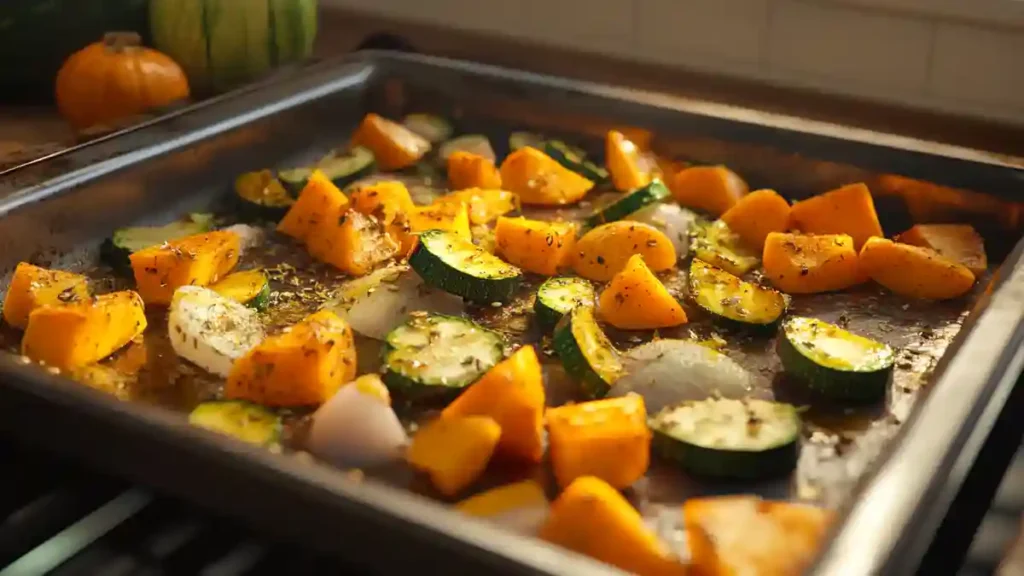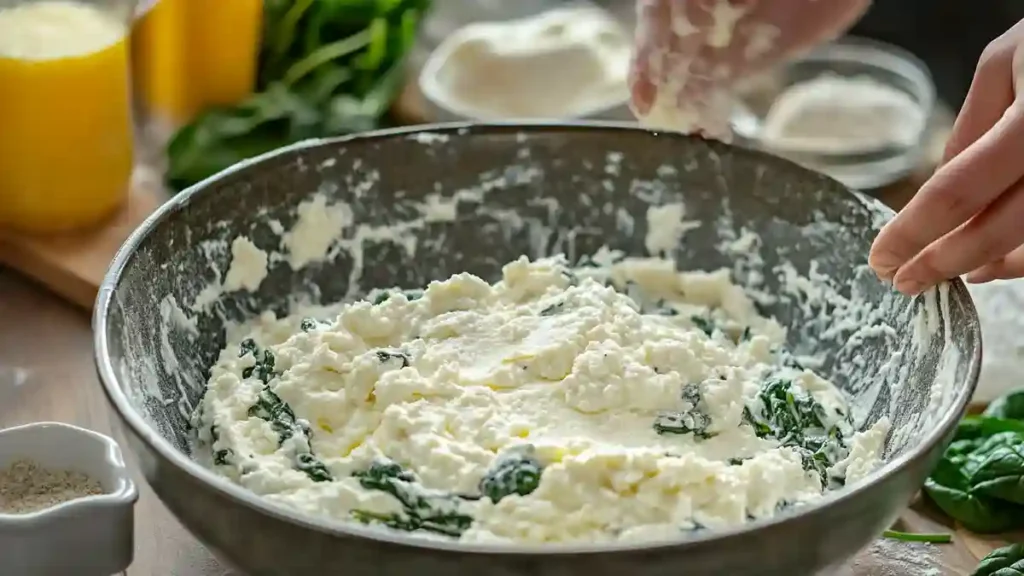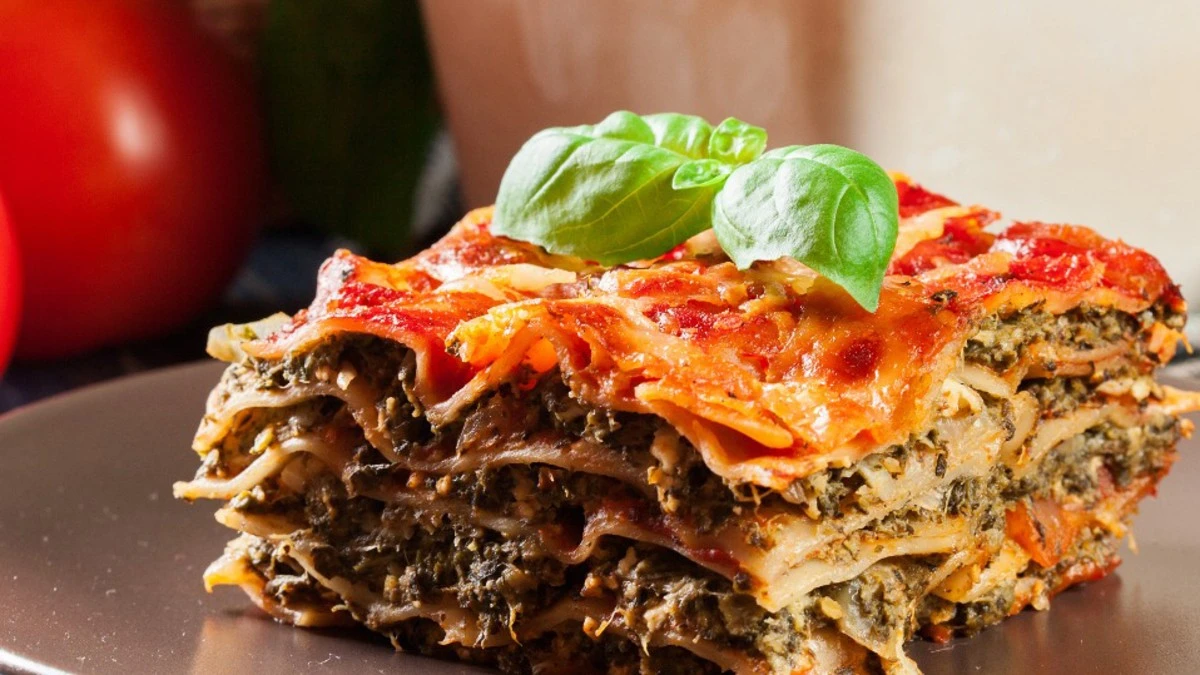Imagine a hot, bubbling lasagne coming out of the oven. The aroma of roasted vegetable and melted cheesy wafting into your kitchen. Lasagna offers comfort and satisfaction. This dish is an excellent way to highlight the vibrant flavors of season vegetables. Vegetarians and meat-lovers will both enjoy it. If you are looking to impress your guests or prepare a meal for the family, this vegetarian lasagne recipe will delight.
Equipment Needed
- Large baking dish
- Baking tray
- Mixing bowls
- Skillet
- Oven
Why You Will Love Vegetarian Lasagna Recipe
- Warm and comforting: The vegetarian lasagne is the perfect meal to warm up on chilly nights.
- Customizable Add your favorite vegetables and make it your own.
- Ideal for Meal Prep The dish is easy to prepare in advance and stores well.
- This recipe is family friendly: Even those who don’t eat meat will enjoy the flavorful Lasagna.
- A healthy meal: With vegetables and protein in abundance, this is a nutritious option.
Key Ingredients & Substitutions
- Sweet potato or butternut squash can be substituted with a similar flavor.
- Spinach You can use fresh spinach instead of frozen. Just wilt before mixing.
- Ricotta. Cottage Cheese can be used as a lighter replacement. Or, for a vegan option, tofu combined with nutritional yeast is an excellent choice.
How to Make Vegetarian Lasagna
Step 1: Roasting your vegetables
Roasting vegetables brings their natural sweetness out. For uniform cooking, you should cut your onions, pumpkins, and zucchinis into the same size pieces. Sprinkle them with olive oil and seasoning, then spread them on a sheet. Then, let them cool a little.

Step 2: Filling the Creamy Shell
In a large bowl, combine the spinach that has been thawed with ricotta cheese, parmesan and seasonings. The egg is used to add richness, and to help bind together the mixture. Mix well until a creamy and cohesive filling is formed.

Step 3: Simmering Sauce
A good sauce is essential to a great Lasagna. Garlic and onion are sauteed until fragrant. Then add the tomatoes and herbs. Let the sauce simmer to bring out its deep flavors. This step can make or break the dish. A well-seasoned sauce is a must.

Step 4: Assembling Layers
To prevent the dish from sticking, add a layer or two of sauce. Then add lasagna sheets and roasted vegetables. Finish with cheese. Repeat until all the ingredients are used. Top with generous amounts of mozzarella.
Step 5: Perfect your baking
Cover initially with foil, to trap moisture and let it cook through. By removing the foil toward the end, you can achieve a beautiful browned top. Let it rest for a couple of minutes prior to cutting. It will help the cheese layers to harden.

Expert Success Tips
- Rest Time is Important: By allowing the Lasagna time to rest after baking, it will keep its shape when you slice it.
- Use Good Ingredients Fresh Vegetables and Quality Cheese make a noticeable flavor difference.
- Adjust seasonings: Try it as you cook! Adjust the herbs, salt or pepper to your personal taste.
Variations and Customizations
- Gluten-Free : You can use zucchini thinly chopped as layers or substitute gluten-free sheets.
- Add more protein to the vegetables: Add lentils, chickpeas, or other legumes to your meal as an additional source of protein.
- Herb Variations Try different herbs such as basil, parsley or even a bit of rosemary to create a unique flavor.
Instructions for Storage and Heating
Any leftovers can be stored in an airtight container for up 4 days in the refrigerator. Wrap the Lasagna in foil tightly and store in a freezer safe container for 3 months. Reheat frozen portions or individual portions using the microwave.
Serving Suggestions
Combine your vegetarian Lasagna dish with a salad dressed with balsamic dressing or with garlic bread to make a meal. You can finish your meal with light desserts like fruit sorbets.
Related Recipes
- Vegetable Mussaka: A Mediterranean take on the classic featuring layers of eggplant, bechamel sauce and a Mediterranean twist.
- Spinach-and-Cheese Stuffed Shells Pasta Shells stuffed with a creamy mixture of spinach and ricotta, and baked in a marinara sauce.
- Chickpeas & Spinach Curry Quick, tasty curry that goes perfectly with Lasagne
Vegetarian lasagne is an appealing, hearty dish for a variety of tastes. This dish is perfect for any event. With layers of roasted vegetable, creamy tomato sauce and creamy ricotta. The recipe is perfect for cooking for your family or friends or for meal preparation for the next week. This comforting classic is easy to make. Just gather the ingredients, get your hands dirty, and have fun! You won’t be let down!
FAQs for Vegetarian Lasagna Recipe
What can I use instead of meat for lasagna?
There are many delicious alternatives to meat in a vegetarian lasagna recipe. Common substitutes include mushrooms, lentils, tofu, or a mix of hearty vegetables like zucchini, bell peppers, and spinach. Ricotta cheese, cottage cheese, or even mashed chickpeas can also add texture and protein. If you’re looking for a twist, a vegetarian Mexican lasagna might use black beans and corn for a flavorful, plant-based filling. Whether making a classic vegetarian lasagna Ina Garten style or a gluten-free vegetarian lasagna, there are endless ways to replace meat while keeping the dish hearty and satisfying.
How do you keep veggie lasagna from getting soggy?
To prevent a vegetarian lasagna from becoming soggy, it’s important to properly prepare the vegetables. Sautéing or roasting high-water-content vegetables like zucchini and mushrooms before layering them in the lasagna helps remove excess moisture. Another trick is to use slightly less sauce or a thicker sauce to prevent too much liquid buildup. If using frozen spinach, be sure to squeeze out as much water as possible before adding it. Whether making a gluten-free dairy-free vegetarian lasagna or a white sauce lasagna recipe vegetarian, controlling moisture is key for a firm and delicious final dish.
What is a good pasta substitute for lasagna?
For those avoiding traditional pasta, there are several great substitutes for lasagna sheets. Thinly sliced zucchini, eggplant, or butternut squash can replace noodles in a no pasta lasagna vegetarian recipe. Another option is using gluten-free lasagna sheets for a vegetarian gluten-free lasagne. Some creative variations, like a vegetarian Mexican lasagna recipe, might use corn tortillas instead of pasta. If you want a protein-packed alternative, try using sheets of tofu or layers of mashed cauliflower.
What is the secret ingredient in lasagna?
Many chefs have their own secret ingredient for making the perfect vegetarian lasagna, but one common addition is a pinch of nutmeg in the ricotta or béchamel sauce, which enhances the depth of flavor. Another trick is adding a splash of balsamic vinegar or red wine to the tomato sauce to create a rich, complex taste. If making a vegetarian white lasagna recipe, try using roasted garlic in the sauce for an extra layer of flavor. Some even swear by adding a bit of mascarpone or cream cheese to the cheese mixture for a richer texture.
Why add tomato paste to lasagna?
Tomato paste is often added to vegetarian lasagna recipes to create a thicker, richer sauce. It enhances the depth of tomato flavor and helps balance acidity in the dish. In a vegetarian Mexican lasagna, adding tomato paste to a spicy tomato sauce can help intensify the overall flavor. It’s especially useful when making a frozen vegetarian lasagna, as it prevents the sauce from becoming too watery after reheating. Whether preparing a traditional red sauce lasagna or a vegetarian white lasagna recipe, tomato paste can elevate the dish.
What not to do when making lasagna?
There are a few common mistakes to avoid when making vegetarian lasagna:
Skipping the pre-cooking step for veggies – High-moisture vegetables like zucchini and mushrooms should be sautéed first to prevent a watery dish.
Overloading with sauce – Too much sauce can make the lasagna fall apart when sliced.
Not layering properly – Even layers of noodles, sauce, and cheese create a well-balanced bite in every forkful.
Skipping the resting time – Letting the lasagna sit for 10–15 minutes after baking helps it set and makes slicing easier.
Using cold ingredients – Starting with room-temperature ricotta or sauce helps everything cook evenly.
Whether making a Costco vegetarian lasagna, a frozen lasagna vegetarian, or a homemade version, following these tips will ensure a perfect dish every time.

Vegetarian Lasagna Recipe: A Hearty Delight
Ingredients
Roasted Vegetables:
- 500 g 1 lb pumpkin, cut into 2cm cubes
- 2 large zucchinis cut into 2cm chunks
- 2 onions cut into wedges
- 2 tbsp olive oil
- 1 minced clove of garlic
- Taste of salt and pepper
Spinach Ricotta Filling:
- 250 g 8oz, thawed frozen spinach
- 500 g 1 lb ricotta cheese
- 1 cup grated parmesan 50g
- 1 egg
- 1 garlic clove minced
- 1/8 teaspoon grated nutmeg
- Half a teaspoon of each salt and pepper
Tomato Sauce:
- 1 tbsp olive oil
- 1 garlic clove minced
- One small onion finely sliced
- 700 g 24 oz tomato passata
- 400 g 14 oz. crushed tomatoes
- Water: 1/2 cup 125 ml.
- 34 tsp dried Oregano Thyme
- 1/2 tsp dried chili flakes optional
- Salt and pepper to your taste
- Lasagna Layers
- Roasted red pepper strips in a 330 g jar
- Fresh Sheets and Lasagne.
- 300 g shredded mozzarella cheese
Instructions
- 1. Roasting Vegetables
- Pre-heat the oven to 200degC.
- In a large mixing bowl, combine pumpkins, zucchinis and onions. Add olive oil, garlic minced, salt, pepper, and the minced garlic. Toss the ingredients to coat.
- Spread out the vegetables in a single-layer on a baking pan and roast at 350°F for 25 minutes. Rotate halfway through and continue to roast until they are soft and slightly caramelized.
2. Preparing the Spinach-Ricotta Filling:
- In a bowl, combine spinach defrosted, ricotta (or ricotta-parmesan), egg, garlic minced, salt, pepper, and nutmeg if you are using it. Mix until well blended and set aside.
- 3. Prepare the Tomato Sauce
- Heat the olive oil in a pan over medium-high heat. Add the minced onion and garlic, sautéing until golden.
- Stir in the crushed tomatoes and water. Sprinkle with salt and pepper. Let the sauce simmer for 20 minutes on low heat.
4. Lasagna :
- Heat your oven up to 160degC.
- Spread a large baking pan with a ladleful of tomato paste.
- Layer the lasagna sheets with half the roasted vegetable, tomato sauce and half the mozzarella cheese.
- Add another layer lasagne sheet, followed by spinach ricotta, more lasagna sheets and the remaining roasted vegetable. Then add another layer of tomato paste.
- Finish with one final layer of Lasagne sheets. Top with the remaining tomato sauce.
5. Bake:
- Cover the dish with foil, and bake 25-30 minutes. Remove the foil from the dish and bake an additional 10 to 15 minutes, until the cheese is bubbling and golden.
- Allow the Lasagna to sit for approximately 5 minutes, before cutting it and serving.
Notes
- Use any vegetables that you wish, so long as they can be roasted in 20 to 25 min.
- To get the best results, make sure you use freshly made Lasagne sheets. They won’t absorb any liquid during cooking.
- This lasagne is easy to prepare and can be stored in the freezer or fridge.
